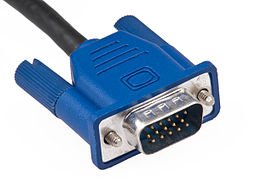In this article we look at RGB video signal: what it is, where it is used, what cables to use and the problems with RGB video. This is the third in a series of articles outlining the different video signals used in home entertainment for connecting VCRs, DVDs, set top boxes, cameras and laptops to TVs and projectors. In the previous articles we looked at Composite video and S-video.
What is RGB video?
In a black & white video camera the image comes through the lens and onto the sensor which generates a video signal representing the image. In a colour video camera, after coming through the lens the signal is split into three different colours (red, green and blue) through prisms. These coloured images then each go to a separate sensor, generating three separate video signals, one with the red picture information, one with the green picture information, and one with the blue picture information. These three separate video signals (Red, Green and Blue) is what is known as RGB video. It is the most pure form of analogue colour video signal.
which generates a video signal representing the image. In a colour video camera, after coming through the lens the signal is split into three different colours (red, green and blue) through prisms. These coloured images then each go to a separate sensor, generating three separate video signals, one with the red picture information, one with the green picture information, and one with the blue picture information. These three separate video signals (Red, Green and Blue) is what is known as RGB video. It is the most pure form of analogue colour video signal.
As well as the three full coloured signals, there also needs to be the timing information to make up picture. We need to appreciate that although a TV picture looks like it is a continuously moving picture, it is actually a series of still pictures (called frames) changing 25 or 30 times a second – and this looks like a continuously moving picture to our eyes. Each frame (still picture) is made up of lots of horizontal lines (525 or 625 lines). All these lines and frames need to be kept in time, or in sync, hence these timing signal are called horizontal sync (H) and vertical sync (V).
Some RGB video signals combine the sync signal with the green coloured picture and some have separate cables for each, requiring 5 signal paths in total.
Where RGB Video is Used
In many countries, RGB video is not used a lot with domestic equipment.
SCART comes from Syndicat des Constructeurs d’Appareils Radiorécepteurs et Téléviseurs. The plugs have 21 pins and allow RGB video, S-video and composite video (along with left and right audio). They are also know as Péritel, 21-pin EuroSCART, Euroconector, EuroAV and EIA Multiport.
The exception is in Europe, where SCART leads are used for connecting between DVD players, Set top boxes and displays.
A number of DVD players are capable of delivering RGB video at their output, but you normally have to enable this in the setup menu. However the display you are connecting to also needs to be able to received RGB video – this is not very common.
Where RGB video is commonly used, is when connecting a laptop to your display. Most flat screens and projectors will accept RGB, with seperate H and V sync (timing signals), referred to as RGBHV. This is the type of RGB video signal available from many computers.

Cables to Use for RGB Video
Scart connectors are widely used in Europe. They are convenient as the video and audio are connected through the one plug, reducing the confusion from having to plug in three video cables and two audio cables.

The standard VGA (Video Graphics Array) plug has been used to connect computers to monitors for many years. They have 15 pins and carry the three RGB coloured signals and separate H sync and V sync. This is the best quality analogue colour signal that a computer can produce. VGA is now the generic term used for this type of plug and cable – it was originally introduced by IBM. Good quality VGA cables can be run up to 50 metres (150 feet). Longer cable runs can use 5 seperate RG59 coax cables. Note: VGA cables only carries video signals, separate cables are are required for audio.
Problems with RGB Video
RGB video may well be the purest form of analogue colour video available, but it is a lot of information to be processed and stored. Remember it is three complete picture waveforms. Therefore it is not easily stored, especially by domestic recorders.
In the next article, we will discuss component video, and see why it is often used in domestic and commercial AV installations.
